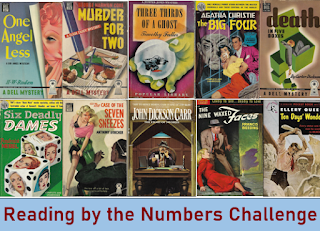Killers of a Certain Age (2022) by Deanna Raybourn
Billie, Mary Alice, Helen, and Natalie were all recruited in the 1970s as part of the first-ever all female class of elite assassins. Known as the Sphinxes, the group work for an organization referred to only as the Museum. All activities are coded with museum references--the assassins work in Exhibitions. The Museum first opened after WWII with a mission to hunt down the Nazis who escaped justice. It later branched out to take on despots and dictators, human traffickers and drug cartels. The ladies got to be part of the last mission to take down a Nazi. Now, 40 years later, their methods are a bit old-fashioned and it's time to retire with a nice pension. But before they completely settle down, the Museum sends them on a fancy all-expense paid cruise.
They discover mid-voyage that the cruise has a price tag after all--a bounty placed on their heads by their own company. Why on earth would the Museum want to get rid of four sixty-year old women, all of whom were put on prize Exhibitions? Targets are named by the board--a three-man team--and all three must agree for a termination to be authorized. So, the ever-resourceful ladies decide to turn the tables and go after the men the who placed the target on their backs. Getting information on how things stand and where those men are involves making contact with the Museum, but who can they trust? The Sphinxes are about to find out whose loyalty can be bought if the bounty is high enough. But that's okay, they know they're the best female field agents the Museum ever had and they're about to show the board that they've still got what it takes to plan an extraordinary Exhibition.
Jumping off of my previous review (The Genesis Secret), this is how to do it if you want a high body count (though, again, it would have been nice if every corpse had been named...). These ladies are assassins--they kill people. When their fellow assassins start hunting them, people die. The book is littered with bodies and they all serve a purpose in moving the story forward. And it's not too grisly. Bonus points for that. Overall, this is just a fun book. It's a girl-power book. I'm not saying I'm in favor of killing people (whether they seem to need it or not), but in a world where this is a thing, then I'm all about don't mess with the girls. And don't think that age is going to make them an easy target. And don't think that just because you're a guy you can automatically outsmart, out-maneuver, and out-fight women who have been in the game for forty years.
The book follows two timelines--we see the beginnings of the Sphinxes. The first few years when they are learning their trade. These scenes are alternated with the present day when the women have retired and find themselves fighting for their lives. The method works--and there are clues in the flashback scenes that can help the reader figure out who is after them and, more importantly, why. It would be fun to see this made into a movie with some feisty actresses of a certain age. ★★★★
First lines: Some of the dates are misleading; some of the names are lies. I'm not trying to protect the innocent. I'm trying to protect the guilty. You'll understand soon enough.
Last lines: People have died for less. I know; I was there.
********************
Deaths = 9 (one natural; two shot; one suffocated; two stabbed; two beaten; one neck broken)











.jpg)
.jpg)




.jpg)
.jpg)

.jpg)

.jpg)
.jpg)






.jpg)



















